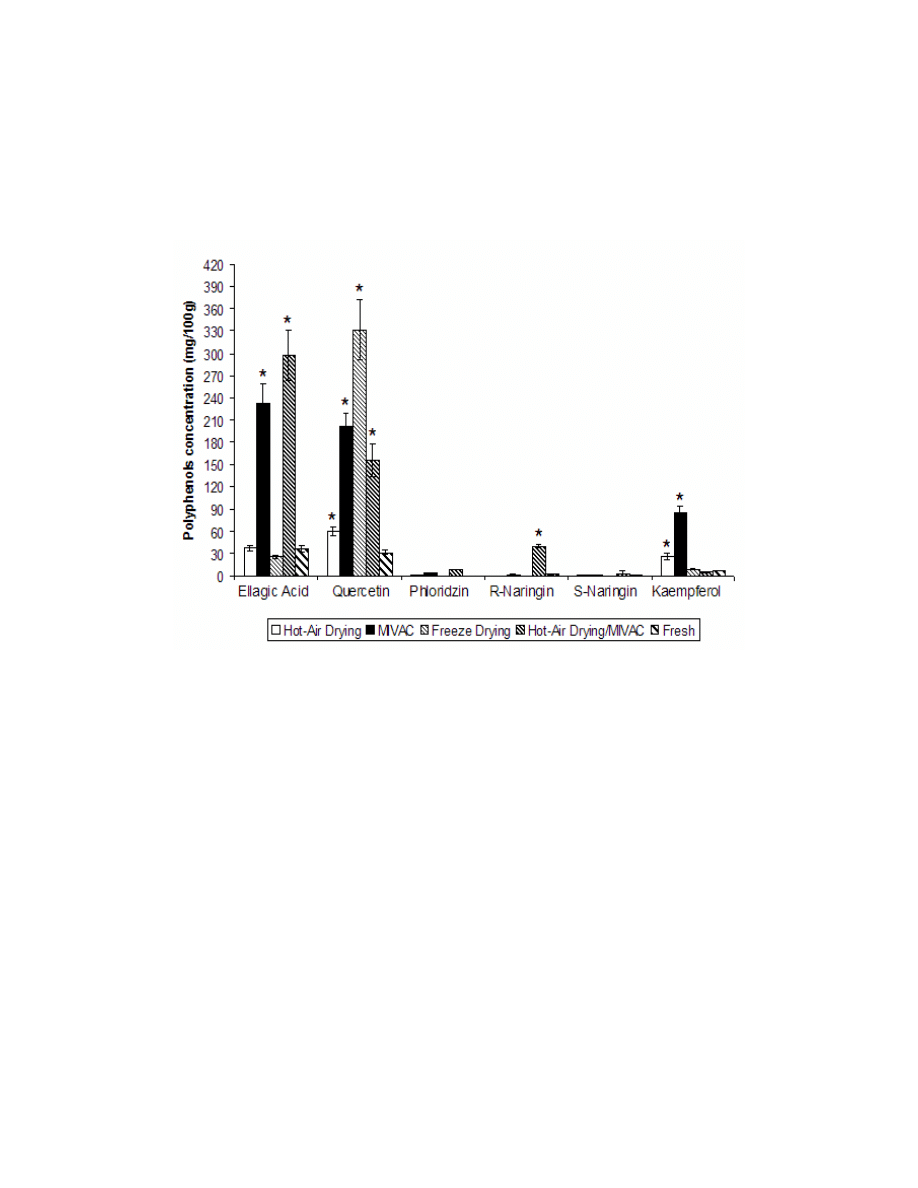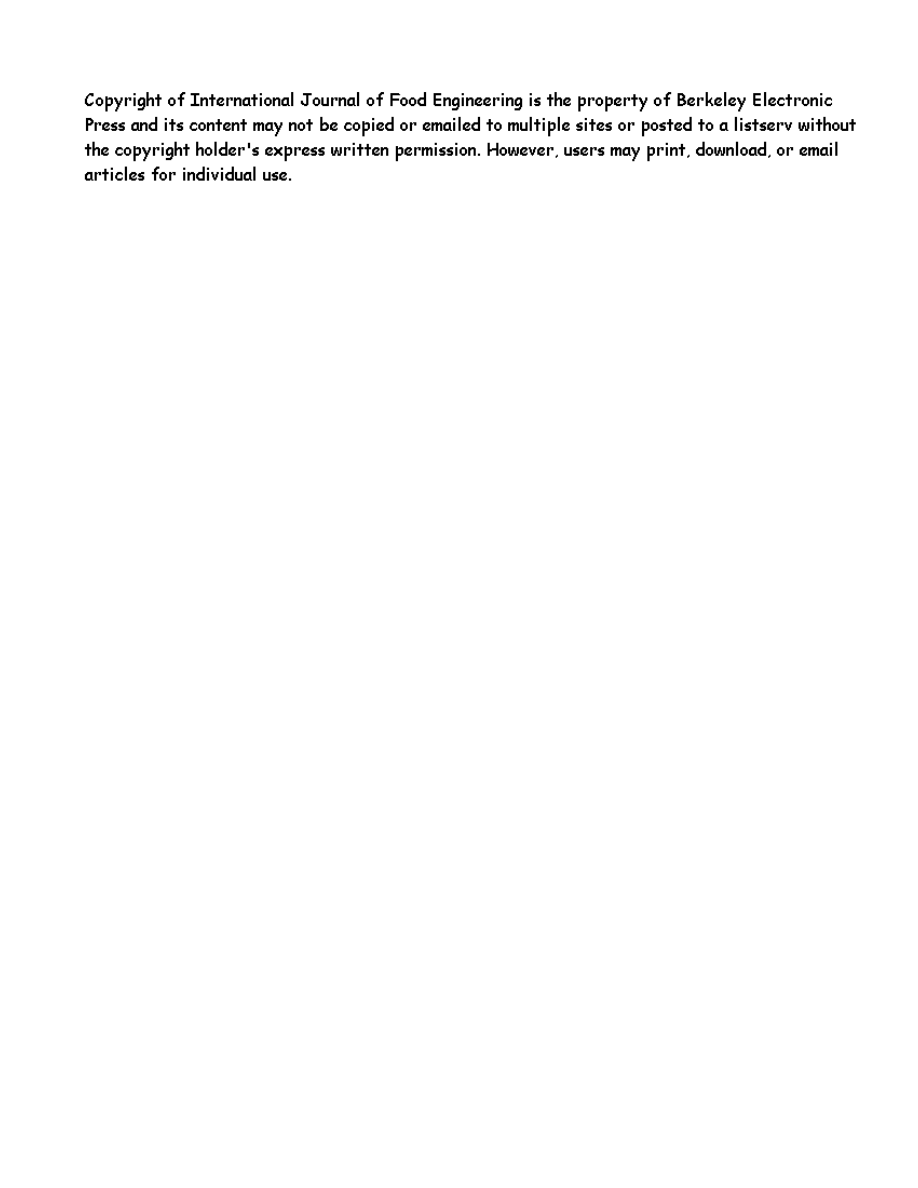
Improving Nutritional Value of Dried
Blueberries (Vaccinium corymbosum L.)
Combining Microwave-Vacuum, Hot-Air
Drying and Freeze Drying Technologies
∗
Esteban I. Mejia-Meza, Jaime A. Yanez, Neal M. Davies, Barbara Rasco, Frank
Younce, Connie M. Remsberg, and Carter Clary
Abstract
Blueberries (Vaccinium corymbosum L.) were dried combining microwave-vacuum, hot-air
drying and freeze drying technologies to retain their nutritional value. Polyphenol retention, total
polyphenols, anthocyanins, and antioxidant activity were evaluated in dried blueberries. Glycoside
compounds for ellagic acid, quercetin, and kaempferol exhibited a higher retention than phloridzin,
and R- and S-naringin in dried blueberries following dehydration. Freeze and HA-MIVAC dried
blueberries had a higher retention of total polyphenols and anthocyanins. Freeze dried blueberries
had higher antioxidant activity, followed by the combination of HA-MIVAC, MIVAC and HA dry-
ing methods. FD, HA-MIVAC and MIVAC treated blueberries had a higher retention of individual
polyphenols than HA treated blueberries, indicating that the nutritional properties of berries may
be retained to a greater extent when these processes are employed.
KEYWORDS: blueberries, dehydration, polyphenols, anthocyanins and antioxidant activity
∗
The authors would like to thank the IMPACT Center, Tree Top Inc, and Washington State Uni-
versity. Author Mejia-Meza was a recipient of a United States Department of Agriculture National
Needs Fellowship.

1.
Introduction
The Pacific Northwest region of the United States of America is a large producer
of berries. A diet high in berries has been associated with a reduced risk of
cardiovascular disease as well as cancer and diabetes due to their high content of
polyphenols (Skupien et al., 2006). Currently different processing method are
being evaluated to determine how processing may affect the levels of these
bioactive agents. Microwave-vacuum (MIVAC
®
) is a newer dehydration method
that often preserves highly desirable food properties since it utilizes significantly
less energy and time compared to atmospheric dehydration technologies.
However, operating expenses may be higher increasing the cost of the dehydrated
product. Therefore, a combination of a conventional drying technique such as hot
air drying with microwave-vacuum and/or freeze-drying could reduce dehydration
costs while preserving nutritional and quality attributes of the dehydrated food.
The objective of this study was to quantify the effect of hot-air, freeze drying and
microwave vacuum drying individually and in combination on the retention of
individual polyphenols, total polyphenols, anthocyanins and antioxidant activity
in dried blueberries (Vaccinium corymbosum L.).
2.
Methodology
2.1 Drying Methods
Freeze Drying Process (FD):
Blueberry samples were treated with calcium
chloride at -23ºC for one hour. Freeze drying was performed using a
Freezemobile 24-Unitop dryer (Virtis Company, Gardiner, NY, USA) at vacuum
pressure of 20 millitorr, heating plate temperature of 20ºC, and condenser
temperature of -60ºC. The drying time to reduce moisture content to 5.0% was 72
hours.
Hot-Air Drying (HAD):
The samples were dried at 76.6 ºC for 4.5 hours in a
custom made hot-air convective dryer to a final moisture content of 5%.
Microwave-Vacuum (MIVAC
®
) Drying:
Microwave-vacuum drying was
conducted using a custom made laboratory microwave vacuum unit that consists
of a magnetron as previously described (Clary et al., 2005). Frozen blueberries
(1000g) were dried at 65.5 ºC for 90 min at 3000 W and a vacuum pressure of 20
torr (2.6 KPa).
1
Mejia-Meza et al.: Phytochemical Content of Dried Blueberries
Published by The Berkeley Electronic Press, 2008

Hot –Air and Microwave-Vacuum Combination Drying (HA-MIVAC®): Fresh
blueberry samples were pre-dried from 50 to 40% moisture content using a
custom built hot-air convective dryer at 98.8 ºC for 45 min. Pre-dried blueberry
samples (1000g) were frozen -10ºF (-23ºC) for an hour and kept frozen at -40ºC.
The frozen samples were dried at 71.1ºC for 60 min at 3000 W and a vacuum
pressure of 20 torr (2.6 KPa).
2.2
Moisture Content and Water Activity Determination
Moisture content in dried fruit was determined using the Association of Official
Analytical Chemists (AOAC) Method 934.06 (AOAC 1990). The water activity
for blueberries was determined using an Aqualab sensor (Model, Decagon
Devices Inc, Pullman, WA, USA) at 25ºC.
2.3
Polyphenol Retention
Polyphenol concentrations were measured using a reverse-phase HPLC method
(Yanez and Davies 2005). The methanolic extraction and enzymatic hydrolysis
was adapted from previous reports to isolate polyphenol glycosides and aglycones
utilizing Helix pomatia type HP-2 followed by incubation for 17–24 h at 37°C
(Yanez et al., 2007).
2.4
Total Polyphenols, Anthocyanins, and Antioxidant Activity
Total polyphenols were determined by the Folin-Ciocalteu reagent method
(Slinkard and Singleton 1977), total anthocyanins according to methods
previously described (Vicente et al., 2002), and anti-oxidant activity via the
ABTS method (Arnao et al., 2001).
2.5
Statistical Analysis
General Linear Model (GLM) Analysis of Variance (ANOVA) with Newman-
Keuls Multiple Comparison Test was utilized with a p-value<0.05 been
statistically significant (NCSS Statistical and Power Analysis, Kaysville, UT).
3
Results
3.2
Polyphenol Retention
Dried blueberries by MIVAC
®
and the combination of hot-air and MIVAC
®
drying (HA-MIVAC
®
) demonstrated significantly (P<0.05) higher retention (232
and 297 mg/100g respectively) of ellagic acid than HA (37.7 mg/100g) and FD
(25.7 mg/100g). Quercetin glycoside was retained a higher concentration in FD
(332 mg/100g) blueberries followed by MIVAC
®
(201 mg/100g), HA-MIVAC
®
(156 mg/100g), and HA (137 mg/100g) drying. MIVAC
®
and HA dried
blueberries showed a slightly higher retention (84.5 and 26.4 mg/100g) in
2
International Journal of Food Engineering, Vol. 4 [2008], Iss. 5, Art. 5
http://www.bepress.com/ijfe/vol4/iss5/art5

kaempferol glycoside, while almost none of this flavonoid was recovered in
freeze and HA-MIVAC
®
dried samples Figure 1). Similar results were observed
for polyphenol aglycones (data not shown)
Figure 1. Polyphenol retention of the glycoside from dried blueberry using
different drying methods (N=9, Mean ± SEM) (wet basis). *Significantly different
from fresh blueberry (P<0.05).
3.3
Total Polyphenols and Anthocyanins
Glycosides were lost during dehydration (Table 1). However, less of the aglycone
form was lost.
The retention of total anthocyanins (glycosides and aglycones form) was
larger in blueberries dried by FD (Table 1).
3.4
Total Antioxidant Activity
Freeze dried blueberry samples retained higher antioxidant activity (4.47 Molar
Trolox/100g sample) in the glycoside forms compared to the other dried blueberry
samples. The HA-MIVAC
®
processed berries had higher antioxidant activity
(aglycone form) than Freeze dried berries. MIVAC
®
and HA dried berries
demonstrated similar ABTS radical oxidation activity, higher than in other
dehydrated samples.
3
Mejia-Meza et al.: Phytochemical Content of Dried Blueberries
Published by The Berkeley Electronic Press, 2008

Table 1. Total polyphenols (g Gallic Acid/100g sample) and total anthocyanins
(mg Pelargonidyin-3-glucoside/100g sample) of dried blueberries by different
drying methods (N=9, Mean ± SEM) (as is basis).
A
Significantly different from
fresh blueberry (P<0.05) MC (Moisture Content).
Drying
Method
Total Polyphenols
(as g gallic acid/100g
sample)
Total Anthocyanins
(as mg pelargonidyin-3-
glucoside/100g sample)
Glycosides
Aglycones
Glycosides
Aglycones
Fresh
(87.2%
MC)
66.8 ± 2.2
294.2 ± 12.9
1.19 ± 0.09
113.4 ± 3.2
Hot-air
Drying
(5% MC)
7.99 ± 0.16
505.4 ± 7.29
A
5.20 ± 0.70
A
67.9 ± 9.7
MIVAC
®
(5% MC)
18.8 ± 2.4
462.6 ± 22.4
A
3.01 ± 0.40
A
176.3 ± 32.2
A
Freeze
Drying
(5% MC)
34.2 ± 1.4
474.0 ± 19.3
A
16.3 ± 0.79
A
291.8 ± 23.1
A
Hot-air
Drying /
MIVAC
®
(5% MC)
23.4 ± 4.7
479.1 ± 5.7
A
7.14 ± 0.6
A
147.3 ± 6.9
A
Table 2. Total antioxidant activity (Molar Trolox/100g sample) of dried
blueberries by different drying methods (N=9, Mean ± SEM) (as is basis).
A
Significantly different from fresh blueberry (P<0.05) MC (Moisture Content).
Drying Methods
Total Antioxidant Activity (Molar
Trolox/100g sample)
Glycosides
Aglycones
Fresh (87.2% MC)
0.46 ± 0.02
3.25 ± 0.05
Hot-air Drying (5%
MC)
0.30 ± 0.03
2.44 ± 0.25
MIVAC® (5% MC)
1.00 ± 0.12A
2.72 ± 0.32
Freeze Drying (5%
MC)
4.47 ± 0.05A
3.51 ± 0.34
Hot-air Drying /
MIVAC®
(5% MC)
0.71 ± 0.07A
4.30 ± 0.64
4
International Journal of Food Engineering, Vol. 4 [2008], Iss. 5, Art. 5
http://www.bepress.com/ijfe/vol4/iss5/art5

4
Discussion
HA, MIVAC
®
and HA-MIVAC
®
dehydration yielded blueberries with moisture
contents ranging between 3-5%, and water activity of 0.170 to 0.240. The
different drying methods had a considerable impact on the retention of individual
polyphenols glycosides and aglycones. HA drying method had the greatest
negative effect on the retention of some individual glycoside and aglycone
compounds such as quercetin, phloridzin, phloretin, R- and S-naringin and
naringenin as well as kaempferol in blueberries. Our results are in agreement with
other reports, suggesting that polyphenols are sensitive to heat and prolonged
thermal treatments, thus also affecting their antioxidant capacity (Lin et al., 1998;
Kwok et al., 2004). Freeze dried and HA-MIVAC
®
dried blueberry samples
showed higher retention in total polyphenols and total anthocyanins (Table 1).
The reason for this effect is because the use of vacuum pressure and low
temperature in the case of freeze drying, and reduced time and temperature for the
HA-MIVAC
®
combination drying method. Kwok et al. (2004) suggested that the
combination of hot-air and microwave vacuum drying led to higher retention of
total anthocyanins and polyphenols in Saskatoon berries than berries processed
solely with hot-air drying (Kwok et al., 2004). Freeze dried berries had the highest
total antioxidant activity and generally provides higher retention of total
anthocyanins and polyphenols than vacuum microwave drying and the
combination of drying methods (Kwok et al., 2004) but this appears to be a
product specific and antioxidant specific effect, because in our study, HA-
MIVAC resulted in similar or greater retention of certain antioxidants in the
aglycone form.
5
Conclusion
Freeze drying resulted in a higher retention of total polyphenols and anthocyanins
as well as higher antioxidant activity in the glycoside forms. Aglycone
polyphenols were more heat stable under the dehydration conditions used here
and, in some cases were present in HA-MIVAC treated blueberries at similar
levels as in the freeze dried. HA-MIVAC
®
led to lower loss of antioxidants and
antioxidant activity than hot air drying
6
References
AOAC. 1990. Official methods of analysis. Washington D.C. 1011-2 p.
Arnao MB, Cano A, Alcolea JF, Acosta M. 2001. Estimation of free radical-
quenching activity of leaf pigment extracts. Phytochem Anal 12(2):138-
43.
5
Mejia-Meza et al.: Phytochemical Content of Dried Blueberries
Published by The Berkeley Electronic Press, 2008

Clary CD, Wang S, Petrucci VF. 2005. Fixed and incremental levels of
microwave power application on drying grapes under vaccum. Journal of
Food Science 70(5):344-9.
Kwok BHL, Hu C, Durance T, Kitts DD. 2004. Dehydration techniques affect
phytochemical contents and free radical scavenging activities of saskatoon
berries (Amelanchier alnifolia Nutt.). Journal of Food Science 69(3):122-
6.
Lin TM, Durance TD, Scaman CH. 1998. Characterization of vaccum microwave,
air and freeze dried carrot slices. Food Research International 31(2):111-7.
Skupien K, Oszmianski J, Kostrzewa-Nowak D, Tarasiuk J. 2006. In vitro
antileukaemic activity of extracts from berry plant leaves against sensitive
and multidrug resistant HL60 cells. Cancer Lett 236(2):282-91.
Slinkard K, Singleton VL. 1977. Total Phenol Analysis: Automation and
Comparison with Manual Methods. AM J Enol Vitic 28(1):49-55.
Vicente AR, Martinez GA, Civello PM, Chaves AR. 2002. Qualoty of heat-
treated strawberry fruit during refrigerated storage. Postharvest Biology
and Technology 25:59-71.
Yanez JA, Davies NM. 2005. Stereospecific high-performance liquid
chromatographic analysis of naringenin in urine. J Pharm Biomed Anal
39(1-2):164-9.
Yanez JA, Miranda ND, Remsberg CM, Ohgami Y, Davies NM. 2007.
Stereospecific high-performance liquid chromatographic analysis of
eriodictyol in urine. J Pharm Biomed Anal 43(1):255-62.
6
International Journal of Food Engineering, Vol. 4 [2008], Iss. 5, Art. 5
http://www.bepress.com/ijfe/vol4/iss5/art5

Wyszukiwarka
Podobne podstrony:
Experimental study on drying of chilli in a combined Microwave vacuum rotary drum dryer (Weerachai K
Approaches to improving the quality of dried fruit and vegetables
Characterization of microwave vacuum drying and hot air drying of mint leaves (Mentha cordifolia Opi
Energy Consumption and Colour Characteristics of Nettle Leaves during Microwave, Vacuum and Convecti
Effective Moisture Diffusivity of Plain Yogurt Undergoing Microwave Vacuum Drying
The drying kinetics of kale (Brassica oleracea) in a convective hot air dryer
Modelling of dehydration rehydration of orange slices in combined microwaveair drying
Preparation of garlic powder with high allicin content by using combined microwave–vacuum and vacuum
Drying kinetics and rehydration characteristics of microwave vacuum and convective hot air dried mus
Headspace Volatiles and Physical Characteristics of Vacuum microwave, Air, and Freeze dried Oregano
Combined osmotic and microwave vacuum dehydration of Apple and strawberries
Dehydration of Carrots by a Combination of Freeze Drying, Microwave Heating and Air or Vacuum Drying
Drying of garlic (Allium sativum) cloves by microwave hot air combination
nutritional modulation of immune function
Improving Grape Quality Using Microwave Vacuum Drying Associated with Temperature Control (Clary)
Creating The Value of Life
WIRELESS CHARGING OF MOBILE PHONES USING MICROWAVES
[2006] Application of Magnetic Energy Recovery Switch (MERS) to Improve Output Power of Wind Turbine
Drying, shrinkage and rehydration characteristics of kiwifruits during hot air and microwave drying
więcej podobnych podstron